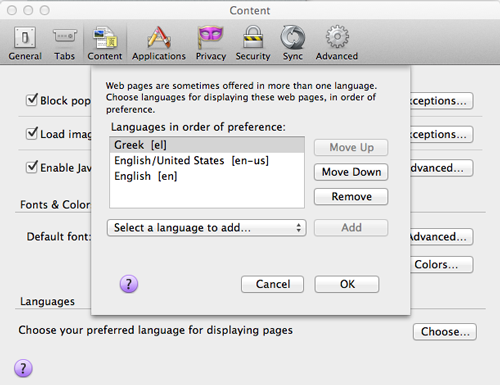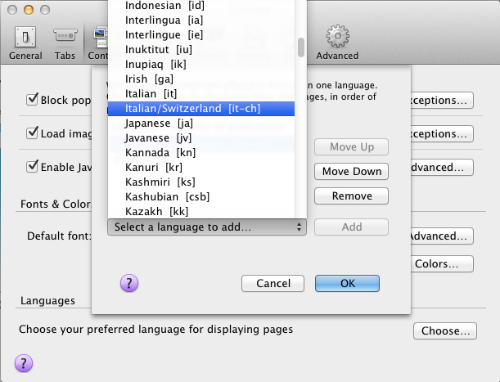This is episode 11, out of a total 12, in the A Node.JS Holiday Season series from Mozilla’s Identity team. It’s the last part about localization, hopefully making you feel all ready to handle that now!
Using Our Strings
So first we added the i18n-abide module to our code, then our Localization (L10n) team did some string wrangling, now we’ve got several locales with translated strings…
Let’s get these strings ready for Node.js and see this puppy in action!
The next step is that we’ll need your PO files, typically in a file system like this:
locale
en
LC_MESSAGES
messages.po
de
LC_MESSAGES
messages.po
es
LC_MESSAGES
messages.po
We need a way to get strings from our PO files into our application at runtime. There are a few ways you can do this:
- Have server side strings and the
gettextfunction provided by i18n-abide will work it’s magic. - Have client side strings and you’ll include a gettext.js script in your code. This is distributed with i18n-abide.
Both of these methods require the strings to be in a JSON file format.
The server side translation loads them on application startup, and the client side translation loads them via HTTP (or you can put them into your built and minified JavaScript).
Since this system is compatible with GNU Gettext, a third option for server side strings is to use node-gettext. It’s quite efficient for doing server side translation.
We’ll use the first option in this blog post, as it is the most common way to use i18n-abide.
compile-json
So, how do we get our strings out of the PO files and into JSON files?
Our build script is called compile-json.
Assuming out files are in a top level directory locale of our project, and we want the .json files to go into static/i18n, we’d do this:
Example:
$ mkdir -p static/i18n
$ ./node_modules/.bin/compile-json locale static/i18n
And we get a file structure like:
static
i18n
en
messages.json
messages.js
de
messages.json
messages.js
es
messages.json
messages.js
compile-json loops over each of our .po files and calls po2json.js on it, producing .json and .js files. po2json.js is another program provided by i18n-abide.
If we take the Spanish messages.po we have so far from these blog posts, we’d see:
# Spanish translations for PACKAGE package.
# Copyright (C) 2013 THE PACKAGE'S COPYRIGHT HOLDER
# This file is distributed under the same license as the PACKAGE package.
# Austin King <ozten@localhost>, 2013.
#
msgid ""
msgstr ""
"Project-Id-Version: PACKAGE VERSIONn"
"Report-Msgid-Bugs-To: n"
"POT-Creation-Date: 2012-06-24 09:50+0200n"
"PO-Revision-Date: 2013-04-24 16:42-0700n"
"Last-Translator: Austin King <ozten@nutria.localdomain>n"
"Language-Team: Spanishn"
"Language: esn"
"MIME-Version: 1.0n"
"Content-Type: text/plain; charset=UTF-8n"
"Content-Transfer-Encoding: 8bitn"
"Plural-Forms: nplurals=2; plural=(n != 1);n"
#: /home/ozten/abide-demo/views/homepage.ejs:3
msgid "Mozilla Persona"
msgstr "Mozilla Personidada"
which would be converted into
messages": {
"": {
"Project-Id-Version": " PACKAGE VERSIONnReport-Msgid-Bugs-To: nPOT-Creation-Date: 2012-06-24 09:50+0200nPO-Revision-Date: 2013-04-24 16:42-0700nLast-Translator: Austin King <ozten@nutria.localdomain>nLanguage-Team: GermannLanguage: denMIME-Version: 1.0nContent-Type: text/plain; charset=UTF-8nContent-Transfer-Encoding: 8bitnPlural-Forms: nplurals=2; plural=(n != 1);n"
},
"Mozilla Persona": [
null,
"Mozilla Personidada"
]
}
}
So we can use these .json files server side form Node code, or client side by requesting them via AJAX.
The static directory is exposed to web traffic, so a request to /i18n/es/messages.json would get the Spanish JSON file.
This static directory is an express convention, you can store these files where ever you wish. You can serve up static files this via Node.js or a web server such as nginx.
Note: You don’t need the .PO files to be deployed to production, but it doesn’t hurt to ship them.
Configuration
i18n-abide requires some configuration to decide which languages are supported and to know where to find our JSON files.
As we saw in the first installment, here is the required configuration for our application
app.use(i18n.abide({
supported_languages: ['en-US', 'de', 'es', 'zh-TW'],
default_lang: 'en-US',
translation_directory: 'static/i18n'
}));
supported_languagestells the app that it supports English, German, Spanish, Chinese (Traditional).- The
translation_directoryconfig says that the translated JSON files are under static/i18n. - Note that
translation_directoryis needed for server side gettext only.
We explained in the first post that i18n-abide will do its best to serve up an appropriate localized string.
It will look at supported_languages in the configuration to find the best language match.
You should only put languages in supported_languages, where you have a locale JSON file ready to go.
Start your engines
Okay, now that configs are in place and we have at least one locale translated, let’s fire it up!
npm start
In your web browser, change your preferred language to one which you have localized.

Now load a page for your application. You should see it translated now.
For a real world example, here is Mozilla Persona in Greek. So, cool!

gobbledygook
If you want to test your L10n setup, before you have real translations done, we’re built a great test locale. It is inspired by David Bowie’s Labyrinth.
To use it, just add it-CH or another locale you’re not currently using to your config under both supported_languages as well as the debug_lang setting.
Example partial config:
app.use(i18n.abide({
supported_languages: ['en-US', 'de', 'es', 'zh-TW', 'it-CH'],
debug_lang: 'it-CH',
...
Now if you set your browser’s preferred language to Italian/Switzerland (it-CH), i18n-abide will use gobbledygook to localize the content.
This is a handy way to ensure your visual design and prose work for bi-directional languages like Hebrew. Your web designer can test their RTL CSS, before you have the resources to create actual Hebrew strings.
Going Deeper
We’ve just scratched the surface of i18n and l10n. If you ship a Node.js based service in multiple locales, you’ll find many gotchas and interesting nuances.
Here is a heads up on a few more topics.
String interpolation
i18n-abide provides a format function which can be used in client or server side JavaScript code.
Format takes a formatted string and replaces parameters with actual values at runtime. This function can be used in one of two flavors of parameter replacements.
Formats
- %s –
formatis called with a format string and then an array of strings. Each will be replaced in order. - %(named)s –
formatis called with a format string and then an object where the keys match the named parameters.
You can use format to keep HTML in your strings to a minimum.
Consider these three examples
<%= gettext('Buy Blue Tickets Now!
') %>
<%= format(gettext('Buy Blue Tickets Now!'), ['/buy?prod=blue&tyep=ticket']) %>
<%= format(gettext('Buy Blue Tickets Now!'), {url: '/buy?prod=blue&tyep=ticket'}) %>
In the PO file, they produce these strings:
Buy Blue Tickets Now!
"
msgid "Buy Blue Tickets Now!"
msgid "Buy Blue Tickets Now!"
The first example has a paragraph tag that shows up in the PO file. Yuck. If you ever change the markup… you may have to update it in every locale!
Also, look at that ugly URL.
Reasons to use format:
- Avoid confusing localizers who aren’t familiar with HTML and may break your code accidentally
- Avoid maintenance issues
The named parameters are nice, in that they are self documenting. The localizer knows that the variable is a URL. String interpolation is quite common in localizing software.
Another example is runtime data injected into your strings.
<%= format(gettext('Welcome back, %(user_name)s'), {user_name: user.name}) %>
Avoid Inflexible Designs
We need to put our L10n hats on early. As early as when we review the initial graphic design of the website.
-
Avoid putting text into images. Use CSS to keep words as plain text positioned over images.
-
Make sure CSS is bulletproof. An English word in German can be many times larger and destroy a
poorly planned design. -
Try this bookmarklet: Fauxgermanhausen das Pagen!
Database-backed websites have already taught us to think about design in a systematic way, but designers may not be used to allowing for variable length labels or buttons.
String Freeze
Remember our build step to prepare files for localizers to translate? And in this post we learned about po2json.js for using these strings in our app… Well, this means we’re going to need to coordinate our software releases with our L10n community.
Continuous deployment isn’t a solved problem with L10n. Either you have to block on getting 100%
of your strings translated before deploying, or be comfortable with a partially translated app in some locales.
L10n teams may need 1, 2 or even 3 weeks to localize your app, depending on how many strings there are. Schedule this to happen during the QA cycle.
Provide a live preview site, so that localizers can check their work.
Wrapping up
In these three blog posts, we’ve seen how to develop a localized app with i18n-abide, how to add a L10n phase to our release build, and lastly, how to test our work.
Localizing your website or application will make your site valuable to an even larger global audience.
Node.js hackers, go make your services accessible to the World!
Previous articles in the series
This was part eleven in a series with a total of 12 posts about Node.js. The previous ones are:
- Tracking Down Memory Leaks in Node.js
- Fully Loaded Node
- Using secure client-side sessions to build simple and scalable Node.JS applications
- Fantastic front-end performance Part 1 – Concatenate, Compress & Cache
- Building A Node.JS Server That Won’t Melt
- Fantastic front-end performance, part 2: caching dynamic content with etagify
- Taming Configurations with node-convict
- Fantastic front end performance, part 3 – Big performance wins by optimizing fonts
- Localize Your Node.js Service, part 1 of 3
- Localization community, tools & process, part 2 of 3
About Austin King
Seattle based non-dogmatic Artist / Programmer type human. Rogue web developer with the Apps Engineering team. Spell check is for the week.
About Robert Nyman [Editor emeritus]
Technical Evangelist & Editor of Mozilla Hacks. Gives talks & blogs about HTML5, JavaScript & the Open Web. Robert is a strong believer in HTML5 and the Open Web and has been working since 1999 with Front End development for the web - in Sweden and in New York City. He regularly also blogs at http://robertnyman.com and loves to travel and meet people.




5 comments